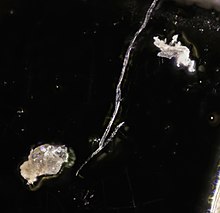| Alarsite | |
|---|---|
 Alarsite crystals found at Tolbachik | |
| General | |
| Category | Mineral |
| IMA symbol | Ars [1] |
| Crystal system | trigonal |
| Crystal class | aluminium arsenate |
| Space group | P3121 (no. 152) or P3221 (no. 154) |
| Identification | |
| Colour | colorless with pale yellow tints |
| Mohs scale hardness | 5-5.5 |
| Luster | vitreous luster |
| Specific gravity | 3.32. |
| Refractive index | nω = 1.596 and nε = 1.608. |
Alarsite (AlAsO4) is an aluminium arsenate mineral with its name derived from its composition: aluminium and arsenate. [2] It occurs as brittle subhedral grains which exhibit trigonal symmetry. It has a Mohs hardness of 5-5.5 and a specific gravity of 3.32. It is semitransparent, colorless with pale yellow tints and shows a vitreous luster. It is optically uniaxial (+) with refractive indices of nω = 1.596 and nε = 1.608.
It was reported from fumaroles in the Tolbachik volcano, Kamchatka, Far Eastern Region, Russia. [3] [4] It occurs in association with fedotovite, klyuchevskite, lammerite, nabokoite, atlasovite, langbeinite, hematite and tenorite. [2]
- ^ Warr, L.N. (2021). "IMA–CNMNC approved mineral symbols". Mineralogical Magazine. 85 (3): 291–320. Bibcode: 2021MinM...85..291W. doi: 10.1180/mgm.2021.43. S2CID 235729616.
- ^ a b Handbook of Mineralogy
- ^ Fact sheet from Mindat.org
- ^ Fact sheet from Webmineral.com
| Alarsite | |
|---|---|
 Alarsite crystals found at Tolbachik | |
| General | |
| Category | Mineral |
| IMA symbol | Ars [1] |
| Crystal system | trigonal |
| Crystal class | aluminium arsenate |
| Space group | P3121 (no. 152) or P3221 (no. 154) |
| Identification | |
| Colour | colorless with pale yellow tints |
| Mohs scale hardness | 5-5.5 |
| Luster | vitreous luster |
| Specific gravity | 3.32. |
| Refractive index | nω = 1.596 and nε = 1.608. |
Alarsite (AlAsO4) is an aluminium arsenate mineral with its name derived from its composition: aluminium and arsenate. [2] It occurs as brittle subhedral grains which exhibit trigonal symmetry. It has a Mohs hardness of 5-5.5 and a specific gravity of 3.32. It is semitransparent, colorless with pale yellow tints and shows a vitreous luster. It is optically uniaxial (+) with refractive indices of nω = 1.596 and nε = 1.608.
It was reported from fumaroles in the Tolbachik volcano, Kamchatka, Far Eastern Region, Russia. [3] [4] It occurs in association with fedotovite, klyuchevskite, lammerite, nabokoite, atlasovite, langbeinite, hematite and tenorite. [2]
- ^ Warr, L.N. (2021). "IMA–CNMNC approved mineral symbols". Mineralogical Magazine. 85 (3): 291–320. Bibcode: 2021MinM...85..291W. doi: 10.1180/mgm.2021.43. S2CID 235729616.
- ^ a b Handbook of Mineralogy
- ^ Fact sheet from Mindat.org
- ^ Fact sheet from Webmineral.com